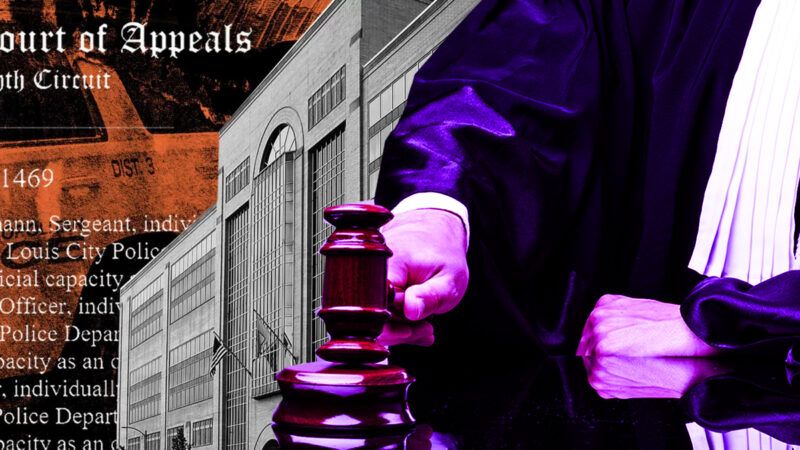He Died After Cops Shackled Him and Held Him Facedown. A Court Said That Was Constitutional. SCOTUS Isn't So Sure.
The officers might receive qualified immunity, however.

In December of 2015, Nicholas Gilbert died in a cell at the St. Louis Metropolitan Police Department (SLMPD). A lawsuit filed by his parents was dismissed by two federal courts, thrown out before mother Jody Lombardo and father Brian Gilbert could make their case before a jury.
The Supreme Court revived it yesterday, writing that the U.S. Court of Appeals for the 8th Circuit failed to properly assess the constitutionality of the officers' use of the prone restraint, kneeling on Gilbert's back as he lay shackled on the ground.
The move is part of a recent willingness by the Court to push back against myopic decisions in qualified immunity and excessive force suits. The U.S. District Court for the Eastern District of Missouri first awarded the SLMPD officers qualified immunity, the legal doctrine that allows government officials to violate your rights without fear of civil accountability unless the manner in which the state allegedly misbehaved has been explicitly deemed unconstitutional in a prior court ruling.
The protections have recently been extended to a group of cops that threw explosives into an innocent, 78-year-old man's house during a botched SWAT raid; a cop who killed a man who had been sleeping in his car; and four cops who assaulted a man they'd pulled over for broken lights. Without a court precedent with near-identical facts, the victims were not permitted to sue for damages.
Last year, the 8th Circuit scaled back even further, ruling that the officers in St. Louis committed no constitutional violation when 10 of them sought to subdue Gilbert, shackling him and holding him in a prone position. He later died at a nearby hospital.
On December 8, 2015, Gilbert was booked for trespassing in a condemned building and failing to appear in court for a traffic violation. After he had been placed in a cell, an officer noticed him tie one end of a piece of clothing around the bars and the other end around his neck. Though no such clothing was in sight when three cops came to help, they attempted to restrain Gilbert, who was 5'3″ and weighed 160 pounds. A struggle ensued, and they put his legs in shackles.
"Several more officers responded. They relieved two of the original three officers, leaving six officers in the cell with Gilbert, who was now handcuffed and in leg irons," the Supreme Court's summary reads. "The officers moved Gilbert to a prone position, face down on the floor. Three officers held Gilbert's limbs down at the shoulders, biceps, and legs. At least one other placed pressure on Gilbert's back and torso." He attempted to lift up his chest, telling them, "It hurts. Stop."
In ruling that no constitutional violation occurred, the 8th Circuit analyzed the case through the lens of Kingsley v. Hendrickson (2015), an excessive force precedent which provides a set of factors via which to determine if a state actor crossed the line. Citing Gilbert's resistance, the judges came to the conclusion that the officers here did not.
But the Supreme Court wasn't entirely swayed. "The court went on to describe as 'insignificant' facts that may distinguish that precedent and appear potentially important," the Court said in an unsigned per curiam opinion, "including that Gilbert was already handcuffed and leg shackled when officers moved him to the prone position and that officers kept him in that position for 15 minutes."
The Court also noted that "St. Louis instructs its officers that pressing down on the back of a prone subject can cause suffocation," and that there is "well-known police guidance recommending that officers get a subject off his stomach as soon as he is handcuffed because of that risk." That same guidance also emphasizes that ongoing resistance "of a prone suspect may be due to oxygen deficiency, rather than a desire to disobey officers' commands."
To be sure, the Supreme Court did not make a decision about whether or not the force was excessive. It merely asked the lower court to reconsider with its counsel in tow.
In dissent, Justice Samuel Alito took issue with that approach. "We have two respectable options: deny review of the fact-bound question that the case presents or grant the petition, have the case briefed and argued, roll up our sleeves, and decide the real issue," he wrote. "I favor the latter course, but what we should not do is take the easy out that the Court has chosen."
Some are a bit more optimistic. "This is significant in that the Court vacated a bad decision employing a very restrictive framework for evaluating excessive force cases. It is important to emphasize, though, that ultimately the defendants in Lombardo may still receive qualified immunity," says Anya Bidwell, an attorney at the Institute for Justice, a public interest law firm. "But we'll take it one step at a time."
Yesterday's decision was indeed another small step in a recent series from the Supreme Court. Though it has hesitated again and again to fundamentally reevaluate the doctrine of qualified immunity, the Court has not shied away in recent months from reprimanding lower courts for the restrictive constitutional readings Bidwell mentions. In November, the Court overturned a 5th Circuit ruling giving qualified immunity to a group of prison guards that forced a naked inmate into a cell covered in human feces and another frigid cell with a sewage leak, where the prisoner was eventually resigned to sleeping in his own urine. In February, the Court resuscitated an Eighth Amendment excessive force suit after a corrections officer pepper-sprayed an inmate for the fun of it. In both of those cases, the lawsuits had been discarded by the lower courts, prohibiting the victims from even stating their case before a group of citizen jurors.


Show Comments (17)